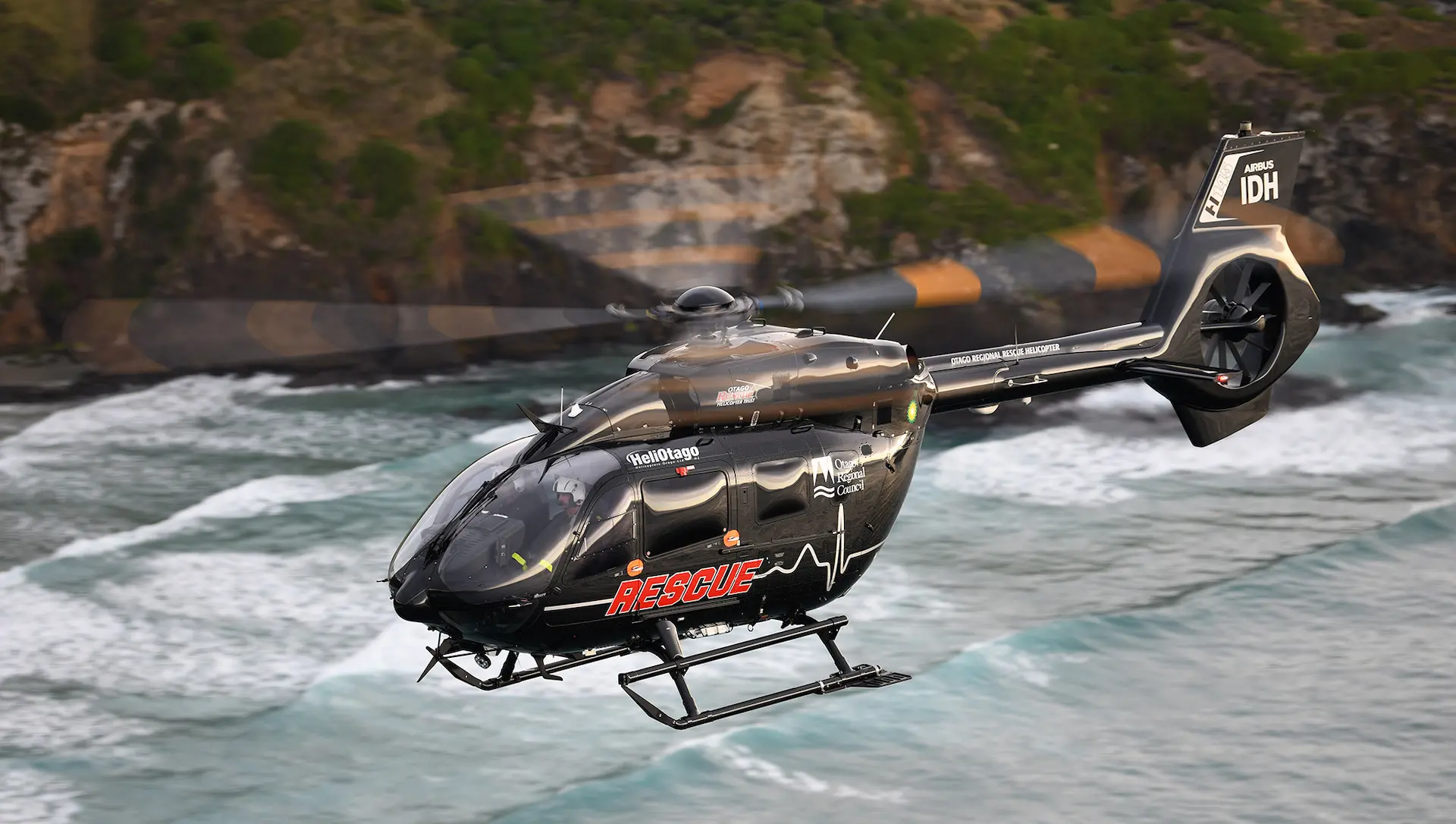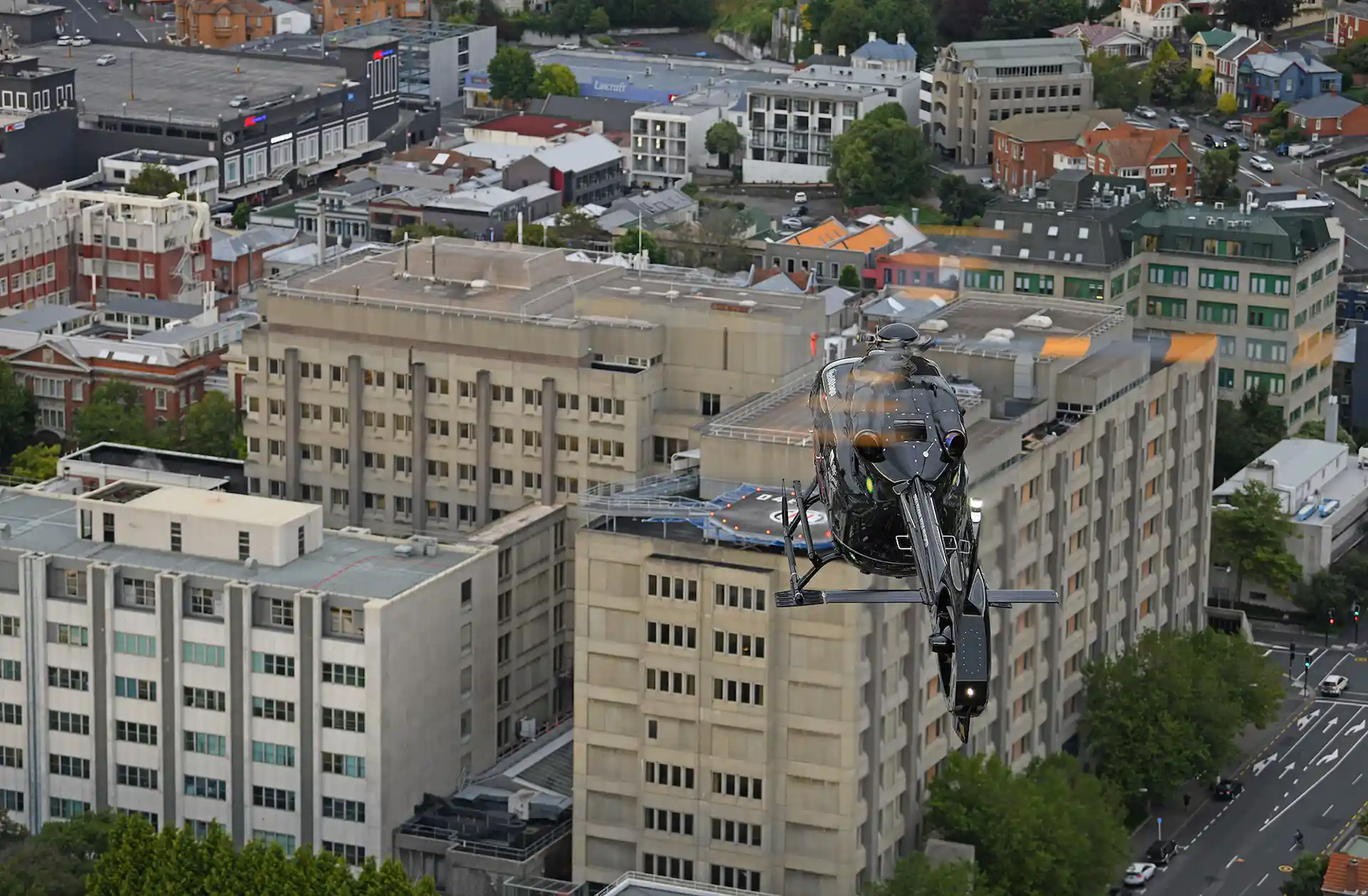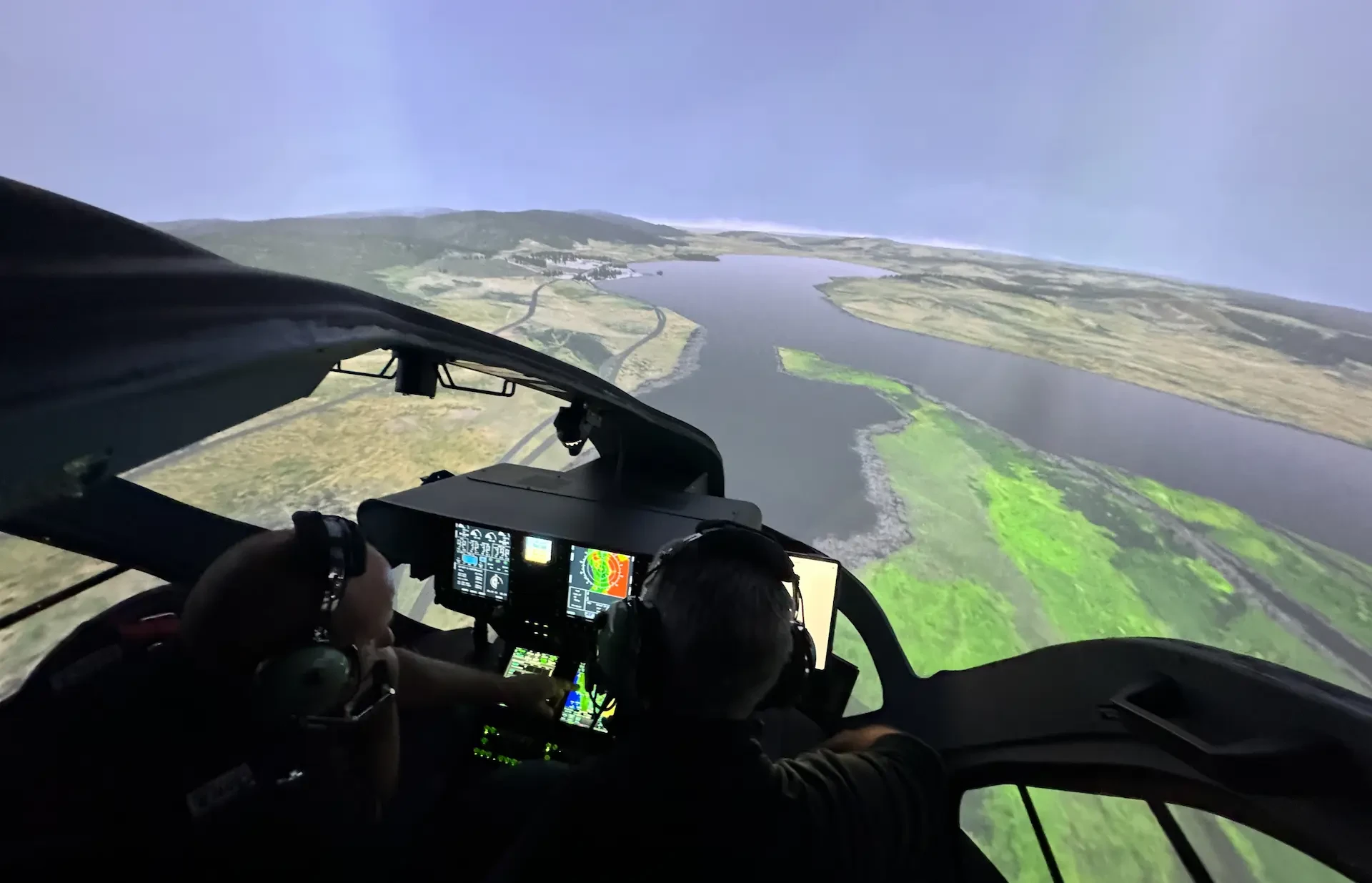As founder and CEO Graeme Gale discussed with HeliOps, Helicopters Otago’s recent purchase of an H145-D3 flight simulator represents a significant investment. The simulator substantially enhances the company’s operational efficiency and safety.
Graeme and Rosslyn (Ros) Gale started Helicopters Otago Limited more than 30 years ago, specializing in agricultural work with a sole
leased MD500. The company has grown significantly over the years to become one of New Zealand’s largest helicopter operators, with a fleet
of over twenty helicopters and ninety staff. Graeme bid to take on the EMS contract for the lower South Island in 1998, and Heli Otago has
successfully operated an ever-growing EMS and air ambulance service since then, now operating five dedicated EMS helicopters from its two
bases in Mosgiel and Queenstown. Gale also owns half of HEMS New Zealand, which holds the helicopter air ambulance contract for the whole
South Island, Stewart Island, the Sub-Antarctic Islands and the associated marine and coastal regions.

In a significant step forward, the company recently purchased a FNPT (Flight and Navigation Procedures Trainer) simulator for the H145-D3 series aircraft, the latest variant of the proven BK117/EC145/H145 types and the basis of Heli Otago’s modern EMS fleet. Gale had previously visited Airbus Helicopters’ Donauworth facility when purchasing H145-D2 aircraft and also purchased an ADT (advanced desktop trainer) for conducting ground courses on the D2. “At that time, it made us the only New Zealand operator to offer ground courses on the H145-D2 but you really needed a Helionix-equipped trainer to properly understand it, so I purchased one. It was quite expensive, but it gave us the operational insight into the Helionix suite that operates the 145,” he recalled. All Heli Otago EMS aircraft are NVG equipped, and the company is still the only provider of Part 145 NVG support in New Zealand.
The company has already taken delivery of three new H145-D3s, with two more on the way, and Gale pointed out that the downside to the ADT
is that you can’t fly in it. The H145 is a very smart aircraft with its Helionix and dual FADEC systems, so there are only so many failures
and emergencies that you can simulate in the real helicopter, which is a very expensive asset – especially when purchased with NZ dollars
that are only around half the value of Euros. “We’re investing heavily in new aircraft, and you really want your pilots to be at the top of
their game, especially in EMS, but they can’t be at that level if you haven’t given them all the right tools to do their training,” he
acknowledged. Normal EMS operations are flown single-pilot IFR, but a second pilot joins the flight crew to enhance safety in such
demanding circumstances as bad weather, off-shore operations or winching missions.

Gale noted that the only two options for getting comprehensive simulator training are sending pilots overseas, usually to Europe or the U.S., or for the company to invest in a simulator. Although the costs of sending pilots away are known variables and can be budgeted for, the most challenging issue is backfilling their positions for the period they are away. “We have to be available 24/7, and that’s one of the main drivers behind us looking at putting in our own simulator. I started looking around and realized that we could not afford the ten million dollar-plus price tag of a full level-D simulator but when I started looking at this Entrol simulator, I recognized that it would possibly be affordable for us here in New Zealand. There are a number of options available around the world, but we needed something that was affordable, cost-effective and that faithfully replicated the D3 as it is in our service. I didn’t just want a sim’, I wanted to have one that actually felt like you were in the aircraft and that could obtain a list of privileges from CAA that let me do almost all our training in the sim’,” he related.
According to Gale, the quality and fidelity of available simulators were of a consistently high standard, but he described the response
from the Spanish company Entrol as outstanding. When he visited Entrol at their base in Madrid, he found a family-owned company that was
highly responsive and at which he was able to meet with one of the owners and, after initially talking to the sales team, was able to
communicate directly with the IT and operational teams that would be building and installing the sim for Heli Otago. “Their commitment to
making it affordable, their attention to detail and their willingness to make changes as we required were all absolute,” he commented.
“That simulator out there is virtually identical to our D3s. It's the same specification, with IBF filters and all the extra little bits
and pieces so that when you hop out of the sim’ and get into the aircraft, there is nothing different. The simulator has motion, and its
field of view is 200 degrees by 70 degrees so it really feels like you’re sitting in a D3 cockpit. You’re immersed in the graphics, and
there’s nothing infringing on your peripheral vision.” Above and beyond the standard graphics level, HD (high definition) imagery is
available, and the Heli Otago simulator has currently got HD graphics for fourteen locations around New Zealand, including major centers
and local hospitals.

As examples of the fidelity and detail in the simulator, Gale advised that its Garmin 750s are genuine articles and not mocked-up items, while the barometric pressure adjustment switch was modified to be two clicks per millibar instead of the original factory setting of one click, to match precisely the setup in the Heli Otago D3s. He noted that one or two very minor detail differences are still to be addressed but expects those to be attended to soon, with the sim’ only having been in service for a month at the time of HeliOps’ visit. “You can simulate every failure that is included in the aircraft flight manual without risking any damage to the real aircraft, everything from oil pressure going high to engine fire, fire suppression activation and engine shut-down,” Gale advised. “There are hundreds of failures available for all the systems. Engines, drivetrain, GPS and avionics are all included and they’re all exactly as per the flight manual. It’s got vortex ring state, retreating blade stall, ice build-up, every exceedance that you can expect to see in the aircraft.”
The simulator is treated exactly like an aircraft, and simulator time can be logged as flight hours, recorded along with all maintenance,
just as for the online airframes. The controllable parameters are extensive, and the Entrol sim’ allows control of the tower, generation
and control of other air traffic, cloud layers, wind, wind shear, icing and turbulence. They are controllable for all phases of flight.
Gale ensured that the CAA (New Zealand’s Civil Aviation Authority) was involved very early in the process of obtaining the simulator. “When
I originally went to Spain, I had Andy McKay – CAA’s Standards Lead (Helicopter) – come and have a look because he was the one who would
eventually be signing it off,” he commented. “There is a whole lot of documentation in the background that CAA need to see and witness,
that confirm procedures are in place to ensure that the simulator remains within parameters, correctly maintained and a fair and accurate
representation of the aircraft it is designed to replicate.

After the sim’ was built, it was air-freighted to New Zealand, and a team of five Entrol technicians travelled over to install it, a process
that took three and a half weeks. “I had initially thought it would take just a few days to set up, but it’s a big piece of kit and a very
big job. They set all the projector screens up with lasers from a datum so everything looks right when you’re flying it,” Gale recounted.
The spherical screen set-up uses six projectors, offers control of the lighting levels and was chosen in preference to the four-projector
flat-screen version and the much more expensive LED screens. “Now that we’ve been using it, I’m extremely happy with what we’ve got,” he
commented. “I’ve already had two pilots fly it who had been overseas and flown a level-D simulator, and they said that it felt more like the
real aircraft and that the graphics were superior, especially as you get closer to the ground. Having flown a level-D myself, that is my
experience as well.”
Although the Entrol unit does not boast what is known as full-motion, Gale reported that the authenticity of in-flight sensations was
highly accurate. “When you crash it, it feels like you crash. When you do an auto-rotation you have to really hit the numbers and it feels
like you’re doing an auto. You can run it on the ground and it feels like you’re running on the ground. Having flown both and regardless of
the price, if I had to choose which I prefer I would pick this. The graphics are better, the response is better and it absolutely
replicates the aircraft that I’ve got,” he opined. The authenticity of the simulation is so good that almost all time in the unit can be
logged as flight time as if it was in the actual aircraft. Exceptions that must be flown in the real aircraft are a three-hour minimum for a
type rating and at least half of the 10-hour minimum ICUS time (in command, under supervision) for air transport operations.
“Although we don’t often speak of how good CAA is, Andy McKay in particular was extremely good and supportive and I came away from those initial dialogues convinced that we should buy it,” stated Gale. When it came to the final certification, two senior CAA delegates came down to conduct test flights and witness the simulator in service. “They are the two senior guys in New Zealand and it is them who will be doing the initial issue of instrument ratings and ATPLs on behalf of CAA. I knew that if it satisfied those guys, it had to be good to go and they were both extremely happy with it,” he reported.
The Entrol sim’ is the only one of its type for the H145 south of Japan. Although Gale has not pursued external operators as simulator
customers, he advised that he immediately started getting interest in it from around New Zealand and from overseas. “We’ve got a lot of
companies that are really interested at the moment. We’ve already had a number of companies from Australia and overseas that operate or are
about to operate the H145, that have come here to do the ground courses, and now they’re interested in the sim’,” he said. “Now, even if we
did none of those, it wouldn’t worry me, but if we can look after New Zealand operators, it will be great to support our own backyard. We’re
not going to use it all day, every day so yes, we can make it available for others and we’ve started to do that now,” Gale advised. This
means that pilots who may otherwise not fly as frequently as optimally desirable can now train, build experience and maintain currency at a
fraction of the operational cost of the real aircraft.

Even with barely a month in service, Gale has had experienced pilots come to him and comment that the sim’ has taught them new things about the aircraft. “Now they’re flying with more confidence, under IFR in particular, so that’s a big deal.” Heli Otago can provide a full service for sim’ training, including instructors, for other operators but he said that his preference is to train their personnel to be sim’ instructors and support them in getting the simulator included in their op spec’s. “I think that the smarter way to do it is to sign them off as instructors so they can train their own people. We’ll provide them all the facilities and support they need but our instructors might do things slightly differently or use different terminology than is standard within their operation,” Gale explained. A booking calendar already shows pilot checks and training bookings up to six months ahead, so it will be simple to insert external customers into that booking process to eliminate scheduling conflicts.
The simulator enables massive savings to be made in aircraft flight time. With an instrument rating taking a minimum of forty hours, not only does the sim’ cut that cost by a huge degree, its 24-hr availability also negates the need to work in with ATC around scheduled airline traffic. The entire rating can be flown in the sim’, including every instrument and flight procedure, at times that suit the operator and pilot. Gale’s original intention was to keep the simulator for Heli Otago’s use only and he remarked, “That was because I’m investing so much capital into new aircraft and because we have an obligation to ensure our pilots are at the top of their game, keeping our crews safe and the patients that we are transporting.” Without access to the simulator, training and check rides would all require an aircraft to be taken off the line so the sim’ increases aircraft availability and minimizes disruptions to the training schedule; an increase in efficiency on both counts. According to Gale, his decision to allow other operators to access the simulator was due in no small part to some pressure from Heli Otago employees who recognized the benefits it could provide to a broader industry clientele.
The simulator is available 24 hours a day, seven days a week and is used daily, with pilots taking full advantage of the increased access
to training and practice. While it is also available throughout the night if circumstances warrant its use, Gale commented that he does not
wish to see night-shift pilots flying it when they should be in bed, resting and available for callouts. “Aside from that, the pilots are
free to jump in and fly it because the costs of an incident or accident far outweigh anything that it will ever cost you to run a
simulator. If we can keep the pilots safe, the aircraft out of trouble, and the doctors, medics and patients safe, I encourage them to get
in there and fly it. It’s not a toy, we treat it as an aircraft and it’s an extremely big deal for here,” he stressed.

Gale pointed out that, without a simulator, there is probably no operator who could honestly say that they are doing everything possible to train effectively for every possible type of emergency and failure in their H145 because it is impossible to carry it through to the final failure in a real aircraft. “The aircraft is both too smart and too expensive to be doing that, but we can do that in the simulator and the pilot can see the exact chain of events and precisely how it all unfolds.” Instead of piling failure after failure on pilots in the sim’, situations are made as realistic as possible, commencing with indicators such as trending temperatures and leading right through to engine fires or failure. The ability to control all facets of weather also means that pilots can train on every route and every instrument procedure available on Heli Otago operations in every conceivable weather condition. This is a significant safety benefit because the company has established quite several instrument routes and procedures to facilitate its EMS service; new routes and procedures that no one else has ever flown before. “Prior to this, I would have to go and physically fly it but now I can do it in the sim’,” Gale noted.
On top of the base-line specification simulator, Entrol offers several add-ons and extras. One of those is a mixed-reality hoist training
simulator station with a clever endless moving cable and generic winch control for tactile realism. Heli Otago will be purchasing one to
expand the capabilities of its simulation suite, but that will not occur until after work is completed on a significant expansion of Heli
Otago’s Mosgiel facility, probably by the end of this year. The current simulator room is a temporary site. The sim’ will be moved to a
dedicated section of the new extension when finished, allowing the MR hoist operator station to be installed in the same location. Although
the hoisting station can be located entirely separately from the flight simulator, Gale pointed out that having them co-located to simulate
the aircraft interior further adds to the authenticity of the simulations and enables the crews to train together as if in the real
aircraft. Of course, moving the sim’, re-installing it and installing the hoist station will all require the further services of Entrol’s
technicians. The planned simulator suite includes the simulator and hoist station, training rooms, accommodation and kitchen facilities, so
customers will be able to stay on site in a veritable one-stop-shop.

Heli Otago is not a huge company but when it comes to operational expertise, it is one of the world’s finest helicopter EMS providers and it
boasts some of the highest flight hours per given timeframe of any H145 EMS operator worldwide. The standard of its modern EMS fleet, the
immensely challenging and varied topography and climate of its 175,000 square km coverage area and the training facilities and standards
available to its pilots make it a benchmark for EMS operational standards. The addition of a dedicated training section with the Entrol
simulator and forthcoming MR hoisting station will also inevitably make it a destination of choice for operators seeking extremely
cost-effective simulator training, in a globally admired operational environment.
 HOME
HOME


